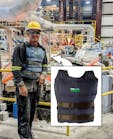Confronting Turnout Gear, Equipment Contamination in the Fire Station
In Parts 1 through 6 of this 6-part series, we discussed diesel exhaust/diesel particulate matter (DPM) and other work-related chemical contaminants as an important health risk to firefighters. We also discussed taking a “systems” approach to protecting firefighters from these kinds of risks, using a management system similar to the incident command system commonly used in firefighting. We considered controlling exposures by understanding exposure pathways, assessing your facility and safety systems, and considering your control options. Finally, we reviewed air sampling methodologies and the importance of monitoring the air to determine the effectiveness of your controls.
All of this focused on diesel exhaust/DPM and dealt primarily with airborne exposures. However, the pathways by which personnel are exposed to hazardous chemicals in a fire station include direct contact and ingestion, as well as inhalation. Much of this direct contact/ingestion exposure is related to the handling of contaminated personal protective equipment (PPE), other turnout gear, equipment and hose.
Risks associated with PPE & equipment
The following are some of the risks associated with contaminated PPE:
- Contact with non-volatile contaminants such as polynuclear aromatic hydrocarbons (PAHs) and diesel exhaust particles.
- Permeation and penetration of some contaminants through and around turnout gear and PPE.
- Inconsistent use of protective gloves and other PPE to prevent contact during overhaul activities.
- Wearing the wrong gloves, that do not provide the required protection.
- Failure to adequately decontaminate turnout gear, hoses and other equipment, especially when made of fabrics or other porous materials.
There has been quite a bit of work done on the risks associated with turnout gear, and several important articles will be cited here
In one article, analysis of used turnout gear and hoods that was cleaned on a yearly basis showed PAHs, arsenic, phthalate plasticizers, and polybrominated diphenyl ether flame retardants (PBDEs). Inner wristlet contamination levels were higher than other areas in contact with skin and could be a focus for routine spot cleaning.
In addition to PAHs and plasticizers, PBDEs have also been shown to accumulate in turnout gear. They are widely distributed and environmentally persistent, even as they are being eliminated during manufacture. They may be found on personal protective clothing worn in contact with the skin, such as hoods and wristlets.
Turnout gear can be contaminated by airborne off-gassing and dust, such as occurs during overhaul activities or when DPM from equipment is not adequately controlled in a station’s apparatus bays. This can expose firefighters, as previously discussed, to a variety of gases, including volatile organic compounds (VOCs) and semi-volatiles such as PAHs, as well as particulates.
Of course, the most important thing firefighters can do to protect themselves from emergency scene exposure is to consistently wear an appropriate respirator during overhaul activities! In one study, overhaul air samples had higher mean concentrations of fine and ultrafine particles than those collected in the firehouse, principally in the apparatus bay and kitchen. Overall firefighter exposures to fine particles and toxic agents were considerably greater than those of the population at the control site studied.
Once back at the station, a variety of VOCs will off-gas from firefighters’ turnout gear following a structural fire response. These may be inhaled by firefighters when they doff their PPE, rehab near their used PPE, wear only part of their PPE when packing up their equipment or store their PPE inside the apparatus’ cabin during the ride back to the station—all of these situations after respiratory protection has typically been removed! In one study, firefighters’ exposures did not appear to be high, overall, when compared to other occupations. However, the authors posited that, given the potential to be exposed to multiple compounds repeatedly throughout a work shift or different combustion byproducts than those they had studied, firefighters should take measures to minimize their exposures to off-gassing chemicals.
Other sources of contamination of turnout gear include manufacturer applied protective coatings. Toxicity and durability of these products should be considered when purchasing gear. Finally, also be aware of mold growing on or near wet gear. Exposure to molds can occur through skin contact as well as by inhalation of airborne molds, mold spores and mold-related gases. Unlike some chemical contaminants, molds are not likely to be absorbed through the skin but can be ingested from contaminated hands and may be irritants.
Management of turnout gear to minimize risks
NFPA 1851, Standard on Selection, Care, and Maintenance of Protective Ensembles for Structural Fire Fighting and Proximity Fire Fighting (2014), is an excellent source on managing turnout gear, addressing Records, Protection of the Public and Personnel from Contamination, Selection, Inspection, Cleaning and Decontamination, Repair, Storage, and Retirement, Disposition and Special Incident Procedures.
In the meantime, the following are several important considerations:
Prompt washing of turnout gear after fire response reduces the amount of contamination to which firefighters are exposed, although it may also have to be balanced against the impact on the lifespan of the gear.
Additionally, decontamination principles, comparable to those followed at a hazmat site, can be followed at the scene of a fire and after training sessions. Frequent hand washing and showering, along with prompt and frequent changing and washing of protective clothing, are also vital parts of staying clear of work-related contaminants.
NFPA 1851 differentiates between routine light cleaning without taking ensemble elements out of service versus advanced cleaning by washing with cleaning agents or specialized cleaning for hazardous materials, including bodily fluids, and decontamination which uses a physical, chemical or combined process.
In a study of the effects of decontamination, PAH levels on turnout gear increased after each response and were greatest for gear worn by firefighters assigned to inside fire attack and to inside search and rescue activities. Off-gassing VOC levels increased post-fire and then decreased 17–36 minutes later, regardless of whether field decontamination was performed. However, field decontamination using dish soap, water, and scrubbing was able to reduce PAH contamination on turnout jackets by a median of 85 percent and cleansing wipes were able to reduce PAH contamination on neck skin by a median of 54 percent. The authors also observed that the consistent use of hoods appeared to offer some protection to the skin of the neck.
Another study showed that, when levels of VOCs, PAHs, hydrogen cyanide and other compounds deposited on turnout gear during structural firefighting are compared with levels after laundering of ensembles, most of the investigated compounds return to pre-exposure levels after washing.
In yet another study, the authors recommend that firefighters should be informed of the risks of exposure to contamination through used turnout gear. They further recommend showering after each time that turnout gear is removed, with a focus on cleaning higher-contamination areas, such as the inner wrist.
As important as proper decontamination and washing are, attention should also be paid to the drying and storage of gear. For the prevention of mold, gear should be fully dried between uses, whenever possible, and you should avoid storing turnout gear in small, unventilated spaces. Such storage conditions may increase the growth of mold and may also result in an increase of toxic compounds over time, resulting in the potential for increased exposure to firefighters.
Store and transport turnout ensembles outside of the apparatus or personal vehicle cabin during the ride back to the station, if possible. After all, as mentioned, it has been demonstrated that most off-gassing of VOCs occurs initially. This is the most vital period during which to avoid riding in a closed cab with used turnout gear. Try to place gear in a protective case or bag to prevent cross contamination, when it must be transported prior to cleaning and/or decontamination.
Also avoid storing gear in direct sunlight to avoid UV degradation of the fabrics. Clean and dry gear before storage and store used ensemble elements in a clean, dry and well-ventilated area, other than for short-term transport, do not store in airtight containers, and always remember not to store or wear gear in living quarters.
Impact of firefighter attitudes
Old cultures honoring dirty turnout gear are changing. Slowly.
In a study of firefighter attitudes toward post-fire decontamination, it was found that, overall, firefighters reported positive attitudes, beliefs, and perceived norms about decontamination, but showering after a fire was the only decontamination process that occurred regularly, with field decontamination, use of cleansing wipes, routine gear cleaning, and other behaviors all occurring less frequently. Firefighters reported time and concerns over wet gear as barriers to decontamination.
While firefighters are aware of the dangers of cancer, have positive attitudes toward clean gear, and believe that clean gear and decontamination will reduce health and cancer risks, they often do not demonstrate individual behaviors consistent with those attitudes. Firefighters report low to moderate frequencies of decontamination after a fire. The authors of this study felt that their results suggested that perceived norms, attitudes toward decontamination, and perceived barriers may influence those behaviors.
The study authors felt that there may also be additional departmental factors that influenced responses, including resources (such as access to extractors for gear cleaning, or ease of sending gear out for advanced cleaning), policies (such as time out of service to complete decontamination), and other organizational cultural factors that were not accounted for in this study. Any intervention to increase decontamination behaviors by firefighters should consider and address both individual and organizational issues.
Finally, to wrap up this series, keep in mind the value of professional interpretation of your findings, whether it be by an architect who specializes in facility design issues, an industrial hygienist for help with air monitoring and contaminant evaluation, or a communications specialist who speaks about these issues with the community. And remember the importance of clear and open communications about these issues, especially with firefighters, so that your controls and solutions address their concerns and are realistic and effective.
Related Articles:
- Confronting Fire Department Diesel Exhaust Exposure Concerns - Part 1
- Confronting Fire Department Diesel Exhaust Exposure Concerns - Part 2: Taking a Systems Approach
- Confronting Fire Department Diesel Exhaust Exposure Concerns—Part 3: Determining Exposure Sources
- Confronting Fire Department Diesel Exhaust Exposure Concerns - Part 4: Evaluating Exposure Pathways
- Confronting Fire Department Diesel Exhaust Exposure Concerns - Part 5: Maximizing Your Resources
- Confronting Fire Department Diesel Exhaust Exposure Concerns - Part 6: Air Testing & Communication of Exposure Results
- Confronting Turnout Gear, Equipment Contamination in the Fire Station






